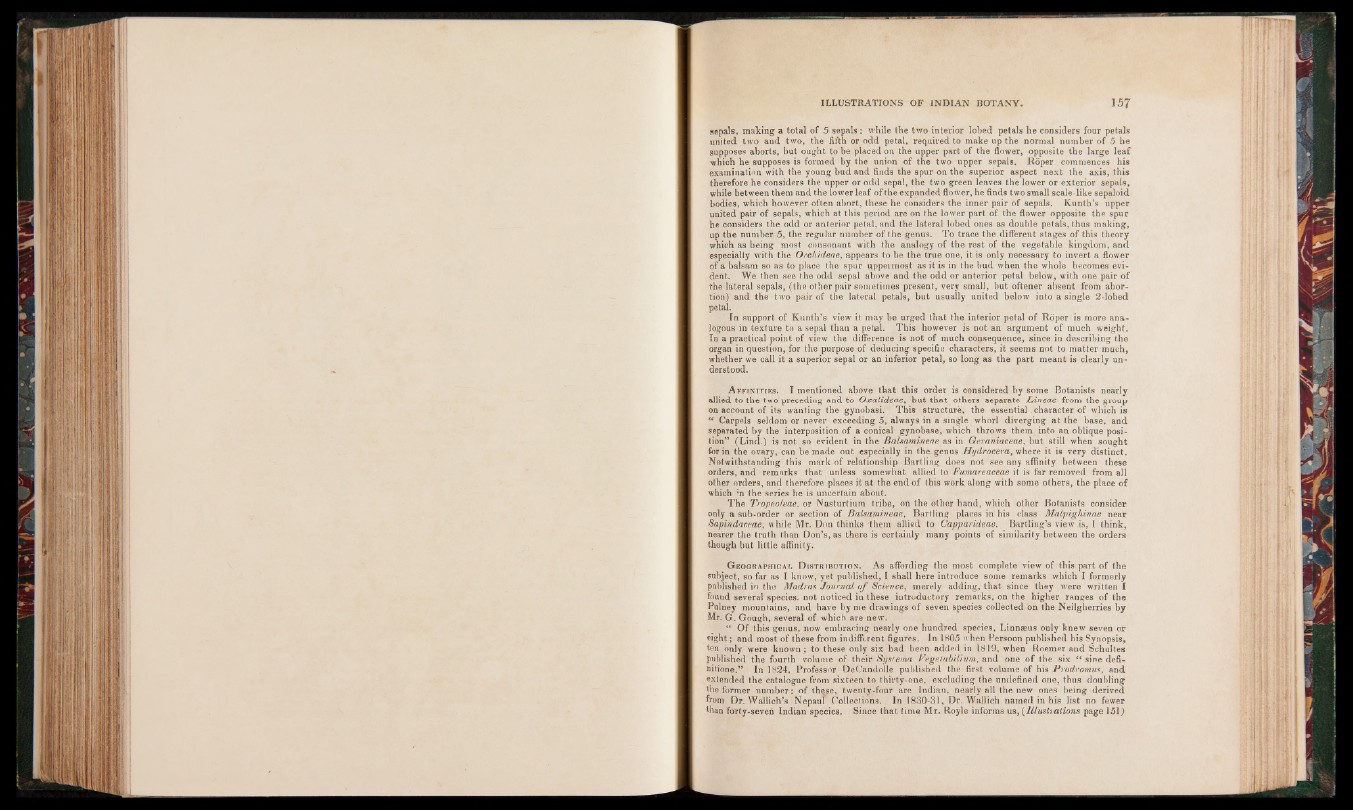
sepals, making a total of 5 sepals : while the two interior lobed petals he considers four petals
united two and two, the fifth or odd petal, required to make up the normal number of 5 he
supposes aborts, but ought to be placed on the upper part of the flower, opposite the large leaf
which he supposes is formed by the union of the two upper sepals. Roper commences his
examination with the young bud and finds the spur on the superior aspect next the axis, this
therefore he considers the upper or odd sepal, the two green leaves the lower or exterior sepals,
while between them and the lower leaf of the expanded flower, he finds two small scale-like sepaloid
bodies, which however often abort, these he considers the inner pair of sepals. Kunth’s upper
united pair of sepals, which at this period are on the lower part of the flower opposite the spur
he considers the odd or anterior petal, and the lateral lobed ones as double petals, thus making,
up the number 5, the regular number of the genus. To trace the different stages of this theory
which as being most consonant with the analogy of the rest of the vegetable kingdom, and
especially with the Orchideae, appears to be the true one, it is only necessary to invert a flower
of a balsam so as to place the spur uppermost as it is in the bud when the whole becomes evident.
We then see the odd sepal above and the odd or anterior petal below, with one pair of
the lateral sepals, (the other pair sometimes present, very small, but oftener absent from abortion)
and the two pair of the lateral petals, but usually united below into a single 2 -lobed
petal.
In support of Kunth’s view it may be urged that the interior petal of Roper is more analogous
in texture to a sepal than a petal. This however is not an argument of much weight.
In a practical point of view the difference is not of much consequence, since in describing the
organ in question, for the purpose of deducing specific characters, it seems not to matter much,
whether we call it a superior sepal or an inferior petal, so long as the part meant is clearly un~
derstood.
Affinities. I mentioned above that this order is considered by some Botanists nearly
allied to the two preceding and to Oxalideae, but that others separate Lineae from the group
on account of its wanting the gynobasi. This structure, the essential character of which is
" Carpels seldom or never exceeding 5, always in a single whorl diverging at the base, and
separated by the interposition of a conical gynobase, which throws them into an oblique position”
(Lind.) is not so evident in the Balsamineae as in Geraniaceae, but still when sought
for in the ovary, can be made out especially in the genus Hydrocera, where it is very distinct.
Notwithstanding this mark of relationship Bartling does not see any affinity between these
orders, and remarks that unless somewhat allied to Fumareaceae it is far removed from all
other orders, and therefore places it at the end of this work along with some others, the place of
which ;n the series he is uncertain about.
The Tropeoleae, or Nasturtium tribe, on the other hand, which other Botanists consider
only a sub-order or section of Balsamineae, Bartling places in his class Malpighinae near
Sapindaceae, while Mr. Don thinks them allied to Capparideae. Bartling’s view.is, 1 think,
nearer the truth than Don’s, as there is certainly many points of similarity between the orders
though but little affinity.
G eographical D istribution. A s affording the most complete view of this part of the
subject, so far as I know, yet published, I shall here introduce some remarks which I formerly
published in the Madras Journal o f Science, merely adding, that since they were written I
found several species, not noticed in these introductory remarks, on the higher ranges of the
Pulney mountains, and have by me drawings of seven species collected on the Neilgherries by
Mr. G. Gough, several of which are new.
“ Of this genus, now embracing nearly one hundred species, Linnaeus only knew seven or
eight ; and most of these from indifferent figures. In 1805 when Persoon published his Synopsis,
ten only were known; to these only six had been added in 1819, when Roemer and Schultes
published the fourth volume of their Systema Fegetabilium, and one of the six “ sine defi-
nitione.” In 1824, Professor DeCandolle published the first volume of his Prodromus, and
extended the catalogue from sixteen to thirty-one, excluding the undefined one, thus doubling
the former number: of these, twenty-four are Indian, nearly all the new ones being derived
from Dr. Wallich’s Nepaul Collections. In 1830-31, Dr. Wallich named in his list no fewer
than forty-seven Indian species. Since that time Mr. Royle informs us, (lllush allons page 151)